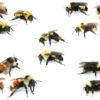Researchers have shown, for the first time, how the genetic material of the Nipah virus replicates in infected cells. The virus can cause fatal encephalitis in humans.
Disease outbreaks and regional epidemics caused by viruses transmitted from animals to humans continue to occur around the world. Many pandemics that spread across national borders also originate from this mode of transmission. Early research into pathogens is essential to ensure that effective drugs and vaccines are available in the event of an epidemic or pandemic.
The World Health Organization (WHO) classifies the Nipah virus as a potentially very dangerous virus for humans. It has caused several outbreaks in Asia in recent years. The virus can be transmitted from bats to humans, causing severe disease that can be fatal in up to 70% of cases. It can also be transmitted from person to person, spreading very quickly. There are currently no targeted drugs or vaccines available to treat Nipah virus infection.
Target for drug development
Researchers led by Prof. Dr. Hauke Hillen, head of the “Structure and Function of Molecular Machines” research group at the Department of Cellular Biochemistry at the University Medical Center Göttingen (UMG) and research group leader at the MPI for Multidisciplinary Sciences, have succeeded in visualizing the three-dimensional structure of the Nipah virus copy machine, also known as RNA polymerase, at molecular resolution for the first time.
The RNA polymerase is responsible for the replication of viral genetic material and the activation of viral genes, and is essential for the replication of the virus in cells. It is therefore a promising target for drug development. The study is published in Nature Communications.
The scientists used cryo-electron microscopy to decipher the three-dimensional (3D) structure of the RNA polymerase. They shock-froze the RNA polymerase in two different states, free and bound to viral RNA, and then took thousands of individual images of the molecule in a state-of-the-art electron microscope. High-performance computers were then used to calculate a 3D structure with almost atomic resolution.
Analyzing RNA polymerase in action
In a second step, the team deciphered how the RNA polymerase interacts with the viral RNA genome during the copying process. To do this, they reproduced this process in a test tube by adding an RNA template and building blocks for the RNA copy, called nucleotides, to the RNA polymerase.
Using biochemical analysis methods, they showed that the purified RNA polymerase was active in the test tube and made new RNA from the nucleotides. The researchers then used cryo-EM to visualize the 3D structure of the RNA polymerase in this active, RNA-bound state at molecular resolution.
“This is an important milestone because until now it was not known exactly what the RNA polymerase of the Nipah virus looks like and how it interacts with the viral RNA. Our data show that it is similar to the RNA polymerases of other related RNA viruses, such as Ebola, but has some special features,” says Prof. Hillen.
The data also reveals how such a viral RNA polymerase uses the genomic viral RNA as a template for the copying process, and how it binds the newly produced product RNA and nucleotide building blocks.
“These results are particularly exciting because a molecular snapshot of the RNA polymerase in its active state has never been visualized before, even for related viruses such as Ebola,” says Dr. Fernanda Sala, postdoctoral researcher in the research group “Structure and Function of Molecular Machines” and first author of the study.
“By comparing the snapshots of free and RNA-bound RNA polymerase, we were not only able to decipher its structure, but also to gain new insights into its dynamics. Such data can be useful in the targeted development of drugs that could inhibit the RNA polymerase.”
More information:
Fernanda A. Sala et al, Structural basis of Nipah virus RNA synthesis, Nature Communications (2025). DOI: 10.1038/s41467-025-57219-5
Provided by
Universitätsmedizin Göttingen – Georg-August-Universität
Citation:
Molecular 3D structure of viral ‘copying machine’ deciphered (2025, March 10)



